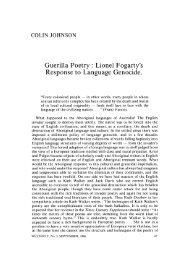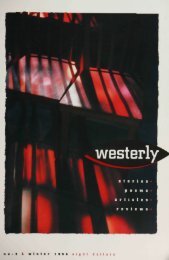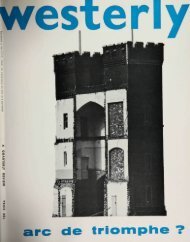Summer Leaves". This continues the Wordsworthian"spots of time" motif of "CurriculumVitae" that concludes The Skylight. In "UnderSummer Leaves", the N.S.W. North Coast of thepoet's childhood is revisited in the light of a tripto Japan. The poem ponders the fate of thedistrict's original black inhabitants at the handsof the white man, and the impending doom ofthe white man in the face of the inevitablecommercial development at the hands of theJapanese entrepreneurs:Then I realised how probably the landI had just walked over was already ownedin some boardroom of Hong Kong or Japan.And all I'd just seenbecame things that lay in a firein the moment when they still have their form.This may seem the simple cri de coeur of ~nancient hippy, recalling the dammerung ofWagner's old Gods and heroes. But it is noaccident, nor a simple racist fear, that it isoriental commercial imperialism that isorchestrating this new rape of the countryside.This poem represents nothing less the poet'sdiscovery of the actuality of Japan, and abeginning realisation of the real historicalsignificance of his beloved haiku and dharmicphilosophy. It is a beginning realisation that thepoetic ideals to which he has aspired, may notbe quite so pure and ideal after all.This brings me back to my earlier allusion toHomer. During many periods of Westernculture the Homeric epic was revered as the idealpoetic form to imitate. It was regarded as the"standard" from which the modem poetry (ofwhatever age) was held to have declined. ForRobert Gray, thus far, the haiku seems to haveconstituted a similar role model: an ideal formembodying the essence of the aspirations ofimpersonality and objectivity, and many othervirtues that became central to the aspirations ofGray, and Western Modernism in general.But from an historical perspective, just as Theflliad can be looked upon as Greek propaganda,the haiku can be regarded as the expression ofprivilege, by the unburdened elite of theJapanese ruling classes. Grey seems to haverealised this implication explicitly after adiscussion with a Japanese Professor:108A professor .said to me, The things youadmireof the past (Ryokan's poems, restraint, rockgardens)only belonged to an elite; it was theywho listened to bamboo, and the eavesdripping,who viewed the moon, and wrotepoems for each other; they who could wanderfrom temple to temple, or stay in some grasshuton their own. Ordinary people in those timesweren't even allowed a family name ...The poet has thus discovered at its source thehistoricity of the imagistic perception andtradition. It is, therefore, little wonder, from thisgeneral feeling of disillusion with thingsJapanese, that Gray has returned to some of themore traditional Western poetic forms anddevices. At the same time, he has escaped theahistorical perspective of Modernism, and in"Under Summer Leaves", has offered a verypertinent piece of contemporary historicalcriticism. The poem displays a much greaterawareness of the complexity of actual issues thataffect "progress" and "development" than wasdisplayed in earlier poems that deplored thedestructive side of civilization. Old sentimentshave thus found a wider perspective.Overall, Piano is a very positive developmentin terms of both form and content in the poetryof Robert Gray. If the mood is pianissimo, it isnot sentimentally so. It is the quiet explorationof newer, more complex territories.Alan UrquhartChildhood and Society in Western Australia,ed. Penelope Hetherington, University ofWestern Australia Press, 1988, $22.50.This book starts with some vivid andhorrifying tales of child abuse in the 1890s, takenfrom the records ofthe Supreme Court ofW.A.,and ends with a censorious paragraph criticisingthe Lady Gowrie Child Centre for attemptingto instil middle-class values in working-classchildren. Thus, the flrst and last pages(disregarding, for the moment, the editor'sIntroduction) are a good indication of thebook's strengths and weaknesses. Strengths -much little-known historical material madeavailable, generally in interesting and livelyform; weaknesses - a curious lack ofperspective or awareness of how the discoveredfacts relate to the present or, for that matter, toeach other, which at times suggests the piece isstill locked into its original framework ofacademic essay or thesis; there is also onWESTERLY, No.2, JUNE, 1989
occasion a tendency toward jargon andconcomitant anachronistic attitudes.The book's cover gives a hint of its basicdilemma. The title, in firm no-nonsense script,is accompanied by a pair of children drawn bythe editor's 7-year old grand-daughter. The bookclearly has an identity problem. Endearing childart on the outside, extensive footnotes on theinside. Who is the intended reader? It is tooscholarly for the general market, at the sametime seems too informal for an academic text.Apart from the reluctance to give details aboutthe thirteen women contributors, there are, evenat a cursory glance, instances of careless editingthat cause uneasiness about possible slipselsewhere, not so immediately recognisable. Forexample, Randolph Stow's novel The Suburbsof Hell is repeatedly referred to as The Suburbof Hell and the running head in the middle ofCarolyn Polizzotto's contribution reads 'PhyllisGarrick.' Even the quote accompanying thephotograph on page 75 is only partiallyappropriate, as the relative paragraph refers togirls in white aprons and makes much of themhaving to play wearing hats. (No hat in sight, andonly a few aprons).Having dispersed with such minor irritations,the way is clear to explore the individual essays,which range from the stylish and lively to theimpersonally informative.The stated aim of the book is to investigatean area neglected by traditional research: Maleadults had been seen as the major actors in thehistorical drama 'moving about apparentlyunencumbered by women and children.' Thismeant that well over half the popUlation hadbeen traditionally ignored, and almost nothingwas known about how children's daily lives hadbeen shaped by their environment and by thedecisions of adults.The essays are organised in three groups: TheReconstruction of Childhood; School andNeighbourhood; Philanthropy Ideology andState. This grouping, despite much inevitableoverlapping, allows an emphasis on the dualperspective of the children's experience and thesocial forces that moulded their lives.At their best they go far beyond theboundaries of their chosen topic. Thus, forexample, Mabel Creelman's Chapter 9, 'Asurrogate Parent Approach to Child Emigration:the First Kingsley Fairbridge Farm School,1912-1924' while, indeed introducing the conceptof 'cottage mothering'is, in fact, more impressiveWESTERLY, No.2, JUNE, 1989as an excellent and interesting short history ofthe Fairbridges and their school. Likewise,Jennie Carter and Jenny Gregory in theircomplementary studies, one of a working classsuburb (Bassendean), the other middle-class(Nedlands) combine personal recollection witha chronicling of local history and achieving,along the way, a quality of freshness andimmediacy. (Only the footnotes break out inacademic absurdities. On checking why some ofthe 'informants' wished to remain anonymous,one finds that they volunteered such startlinginformation as 'Church was one of the greatestthings in Nedlands', or reveal the fact that theMethodist Boys' Badminton Club met on weeknights,or provided details about the number ofprayer meetings attended by Anglican children.)No such reservations hampered Jessie Viner'sreminiscences of a 'Childhood on the Peel.' Abrief introduction by Carolyn Polizzottoprovides a suitable perspective, drawingattention to the incongruity of an idyllicchildhood being possible in the midst of severehardship experienced by the adults in the GroupSettlement Scheme on the Peel Inlet in the 1920s.The reminiscences themselves embody thequintessential myth of the Australian battlerwithout ever turning to cliche, as in the episodeof the impromptu church service with thecongregation sitting on chaff bags and ratsrunning around in the shadows. (The last serviceJessie's mother had attended had been atWestminster Abbey.) Or, the lack of doctorsforcing them into terrible home-cures, with dogsbeing used to lick infected human sores.But while the personal element is the mostimmediately engaging aspect, there are othermemorable contributions.Noelene Reeves graphically reconstructs fromavailable records the daily reality of schoolingin Western Australia circa 1896. Punishmentswere well documented, games not. Concern withovercrowding, discomfort and insanitaryplumbing far outweighs information about thecurriculum, which was severely limited in scope.'The cleaning of slates with sleeves also used ashandkerchiefs was one of the reasons given forpreferring paper and pencil and for recommendingthe discontinuation of the use of slates inschools' and the virulent and fatal nature ofchildhood illness meant that children were nostrangers to the death of a classmate.One of the most impressive contributions isMoira Fitzpatrick's essay on the Mental109
- Page 3 and 4:
CONTENTSWESTERLYVOLUME 34, No.2, JU
- Page 5:
WESTERLYa quarterly reviewISSN 0043
- Page 8 and 9:
JAN KEMPTo My Father, M.H.K.My fath
- Page 10 and 11:
JAN KEMPThe GypsySuddenly before yo
- Page 12 and 13:
WONG PHUI NAMA Death in the WardThe
- Page 14 and 15:
WONG PHUI NAMCousinI had to call to
- Page 16 and 17:
WONG PHUI NAMObitIt is as thin smok
- Page 18 and 19:
So thus I lie here fearful of movem
- Page 20 and 21:
VIRGINIA BERNARDA ValedictionWhen N
- Page 22 and 23:
"Yeah, yeah," I call, returning the
- Page 24 and 25:
she flops for a bit, slurps her tea
- Page 26 and 27:
well her students did, she was neve
- Page 28 and 29:
English or Indian, that they had th
- Page 30 and 31:
ANDREW TAYLORSpringSpring is a dive
- Page 32 and 33:
CAROL SElTZERAiming for the MouthTr
- Page 34 and 35:
GRAEME WILSONA Selection of Japanes
- Page 36 and 37:
a highly ambivalent attitude to his
- Page 38 and 39:
Esson attended some rehearsals of T
- Page 40 and 41:
the literary life of Bloomsbury. Lo
- Page 42 and 43:
Without Yeats Esson would quite lik
- Page 44 and 45:
"What theatre do you have in Austra
- Page 46 and 47:
In the back room Esson could feel t
- Page 48 and 49:
"When we started our little theatre
- Page 50 and 51:
a screen against a wall. A theatre
- Page 52 and 53:
VINCENT O'SULLIVANSinging Mastery:
- Page 54 and 55:
flighty relation in most statements
- Page 56 and 57:
living and the dead; that places hi
- Page 58 and 59:
quite diverse traditions towards th
- Page 60 and 61: WARRICK WYNNEThe Wetlands (for Liam
- Page 62 and 63: JAN OWENSmileOur mother aimed the b
- Page 64 and 65: RICHARD KELLY TIPPINGOlympic Airway
- Page 66 and 67: DAVID REITERBear by the Jasper Road
- Page 68 and 69: (At twenty eight you did not bother
- Page 70 and 71: left, would have risen and walked o
- Page 72 and 73: He had hair like mine used to be, t
- Page 74 and 75: OLIVE PELLThe QuestionTell me how t
- Page 76 and 77: BRIAN MOONANAT 515: MASS LECTURE Th
- Page 78 and 79: PETER KIRKPATRICKTear HereThe bay i
- Page 80 and 81: JOHN WINTERThe Bird ManIn wooded, p
- Page 82 and 83: KNUTE SKINNERAugust 15There's a lig
- Page 84 and 85: M.E. PATTI WALKERThe Hook"Aren't yo
- Page 86 and 87: QMNQMNQMNQMNapartheid man, this is
- Page 88 and 89: QMNQMNQMNeasy because you don't bel
- Page 90 and 91: lands or which have been taken over
- Page 92 and 93: GEOFF GOODFELLOWToo MuchDianne is 1
- Page 94 and 95: SHANE McCAULEYSouth Fremantle, Summ
- Page 96 and 97: JEAN KENTWaiting Out the DroughtWai
- Page 98 and 99: STEPHEN MAGEEJesus Falls, South Aus
- Page 100 and 101: SIMON BROWNBlue Hole, Santothe colo
- Page 102 and 103: CONAL FITZPATRICKA Brown Dog, Off A
- Page 104 and 105: PAUL HETHERINGTONOne RoomIn teeming
- Page 106 and 107: society, or, in the terms of the my
- Page 108 and 109: emphasised (I think) in the referen
- Page 112 and 113: Deficiency Bill in Western Australi
- Page 114 and 115: invocation of pastoral near the beg
- Page 116 and 117: particularly dreaded). The final re
- Page 118 and 119: VINCENT O'SULLIVAN - is one of New







